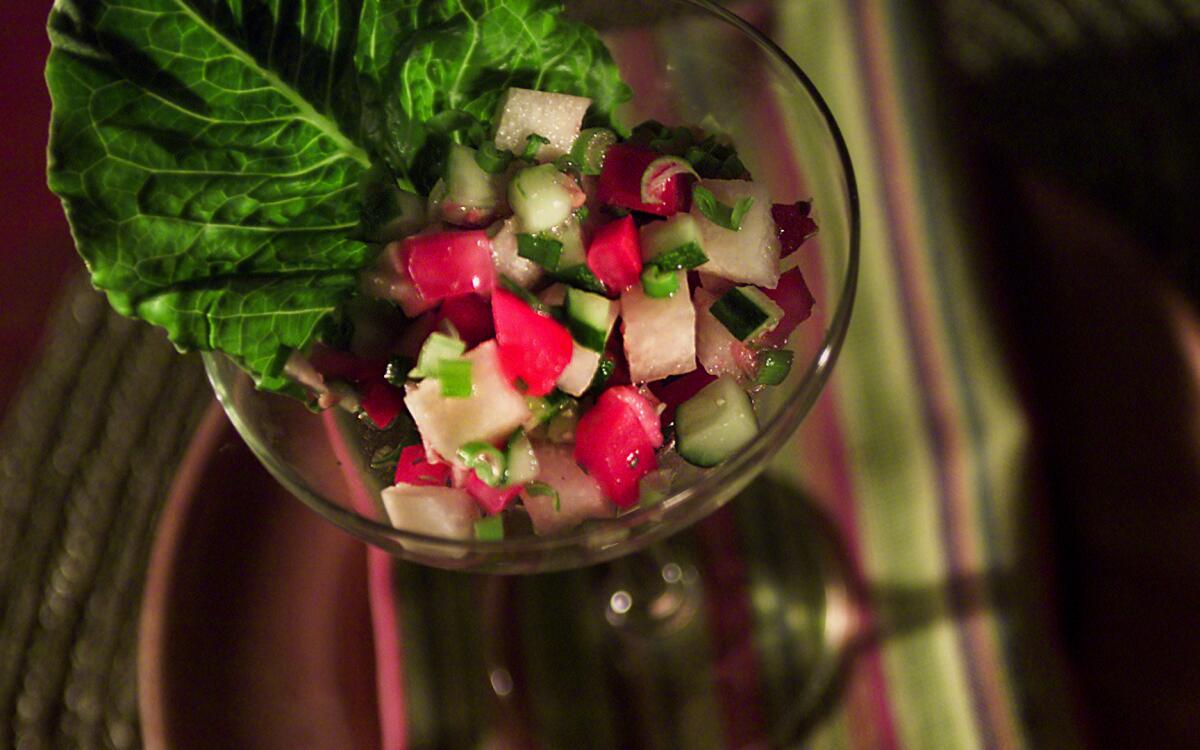Israeli salad, California style

Cucumber and jicama make an odd couple. The cucumber is from Asia and is beloved in the Mediterranean, the Middle East and Europe. But in those areas, jicama is unknown. On the other hand, jicama is a favorite in Mexico, where the cucumber is largely ignored by home cooks.
But I have been matching cucumbers and jicama in my menus for almost 20 years. Since I value traditional cooking, this may seem to be an odd pairing, but the two do share certain qualities--a pleasing crispness and a delicate sweetness.
Purists raise their eyebrows when they hear that I put jicama in my Mediterranean chopped salad. This blend of finely diced cucumbers, tomatoes and onion is known among my relatives as Israeli salad and among my Lebanese friends as Lebanese salad. My Iranian neighbors see it as their own as well. To them it is Shirazi salad, named for the city of Shiraz in southwestern Iran.
The first time I made my chopped salad with jicama was by chance. I was short on cucumbers, but I happened to have a jicama, and so I diced it and mixed it in. Since my husband grew up by the Mediterranean eating the standard salad, I wondered how he would react to this departure from custom. He was delighted with the new “California” Israeli salad and so was I. The jicama’s subtle sweetness complemented the other ingredients and the lemon juice dressing perfectly.
Besides, the new salad was more satisfying and prettier. Since then I have added jicama to the Old World recipe just about every time. This Mediterranean-Mexican medley has become a classic formula in our home.
After that, I turned to other Mediterranean and Middle Eastern appetizers we like, to see if they too would benefit from this New World ingredient. An herb-scented Algerian cucumber and pepper salad with olives, mint, cilantro and vinegar was even more delicious with jicama. A Persian cucumber salad with walnuts and raisins seemed to be waiting for the shredded jicama I added.
Soon I realized that jicama can enhance other dishes featuring cucumbers, especially those with a sweet and sour note--whether European or Mediterranean.
Because of the appealing sweetness of the best cucumbers, Persians serve them with fruit. Mexicans do the same with jicama, for example, adding it to an exotic holiday salad of oranges, pineapple, bananas, beets and peanuts. At an Iranian party in Los Angeles I was impressed by a lovely appetizer of fruit and cucumber wedges; a short time later, I found myself admiring a colorful fruit and jicama platter at a Mexican reception. I thought it would be fun to make a salad combining the two vegetables with fresh fruit.
First I tried a Moroccan radish and orange salad--I replaced the radishes with jicama and added cucumber. The medley was wonderfully refreshing, tasty and attractive. Another North African salad, of oranges and olives spiked with cayenne and cumin, turned out even better. My cucumber-jicama duo were a superb addition, and the spices seemed to highlight their sweetness. The pair also marries well with other juicy sweet-and-tart fruits, such as grapefruit, pineapple, plums and kiwis.
Some people cook jicama, substituting it for water chestnuts in Chinese dishes, while certain French recipes call for braising cucumbers. For me, much of the charm of both vegetables lies in their crisp texture, and I almost always serve them raw.
Not all cucumbers are created equal. The ones I prefer are sold in my neighborhood as Persian cucumbers and in some areas as Middle Eastern cucumbers. They’re slightly longer and slimmer than pickling cucumbers (also called Kirby cucumbers) and possess an intriguing hint of sweetness. Long Japanese cucumbers, which resemble the shrink-wrapped hothouse cucumbers, also are very good. If you happen to enjoy gardening, I’ve found they grow beautifully in Southern California.
When I can’t find either of these, I opt for pickling or for hothouse cucumbers. The common cucumbers available at all grocery stores taste fine at the peak of their summer season but are my last choice during the rest of the year.
To the uninitiated, jicama’s appearance might seem forbidding--they look like large, tan turnips. Yet their tough, brownish peel conceals tender white flesh. They are at their best when they are fresh or labeled “new crop” at the market. You can recognize them by their skin--it’s thinner and more tender, and its color is paler, almost a cream color. Often they’re sweeter and their texture is more delicate. The flavor somewhat resembles an apple with no acidity. I’ve heard jicama’s texture compared to that of radishes but its flavor has none of the sharpness. Kohlrabi lovers compare jicama to this vegetable.
Like many odd couples, the appeal may be hard to pin down, but it is undeniably there.
*
Faye Levy is the author of “1,000 Jewish Recipe” (Hungry Minds, $35) and of the award-winning “Faye Levy’s International Vegetable Cookbook” (Warner, 1993).
Napkins and placemats from Crate & Barrel stores.
Mix the cucumbers, jicama, tomatoes and green onions in a shallow bowl. Add the oil, lemon juice and salt, pepper and hot sauce to taste. Serve chilled or at room temperature.
Get our Cooking newsletter.
Your roundup of inspiring recipes and kitchen tricks.
You may occasionally receive promotional content from the Los Angeles Times.















